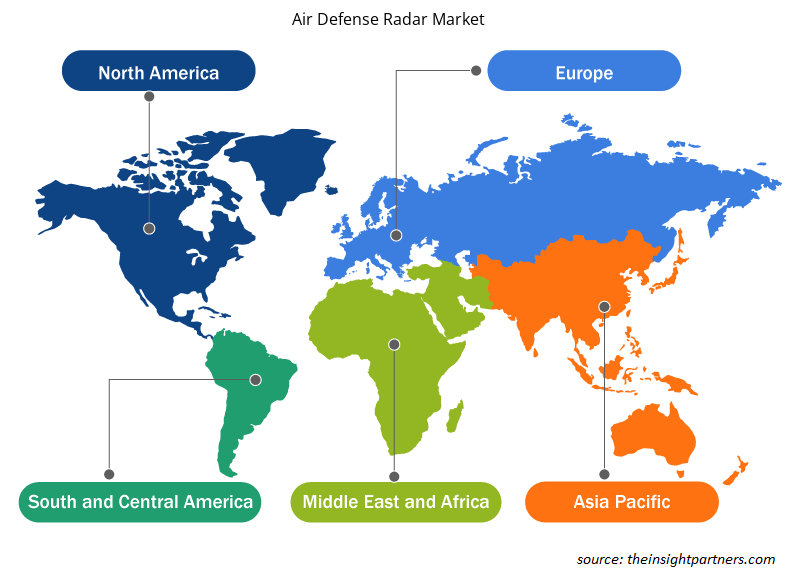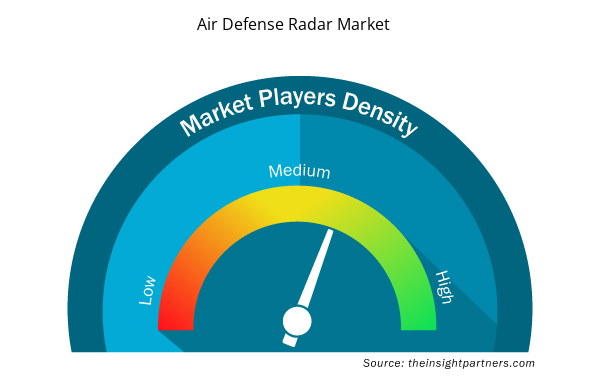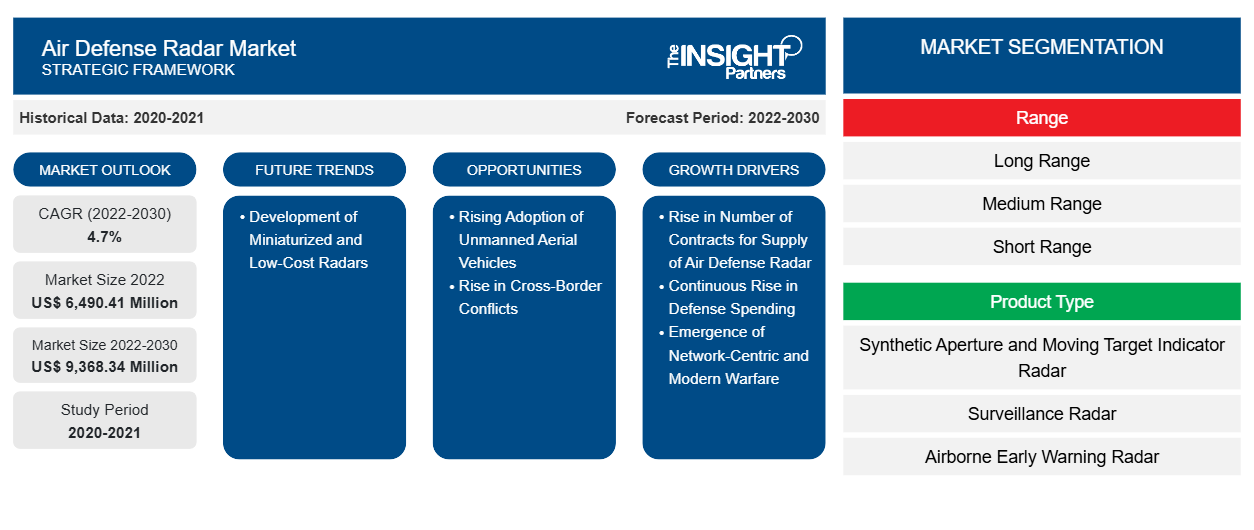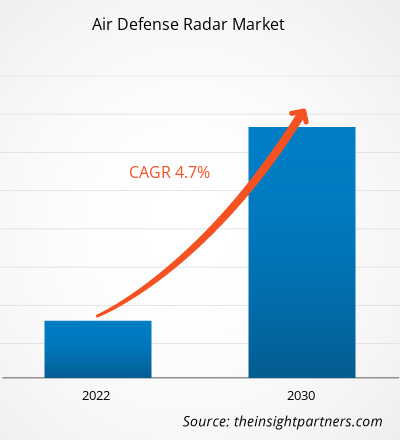防空レーダー市場規模は、2022年の64億9,041万米ドルから2030年には93億6,834万米ドルに達すると予測されています。市場は2022年から2030年にかけて4.7%のCAGRを記録すると予想されています。小型で低コストのレーダーの開発は、今後も防空レーダー市場の主要なトレンドであり続けると思われます。
防空レーダー市場分析
妨害やスプーフィングの手法は、防空レーダー システムが提供する状況認識を低下させる可能性があります。レーダー信号を妨害したり、偽の情報を提供したりすることで、これらの手法はオペレーターや意思決定者を誤解させ、脅威の不正確な評価につながる可能性があります。状況認識が低下すると、空中の脅威に効果的に対応する能力が損なわれ、ミッション全体の成功が危うくなる可能性があります。レーダー システムの製造元とオペレーターは、妨害やスプーフィングの手法の影響を軽減するための対策を継続的に開発しています。これらの対策には、高度な信号処理アルゴリズム、適応波形生成、または補完的なセンサー システムの統合が含まれる場合があります。ただし、対策が進化するにつれて、敵はより高度な妨害やスプーフィングの手法を開発する可能性があり、研究開発への継続的な投資が必要になります。妨害やスプーフィングの手法の影響を軽減するには、多くの場合、追加のテクノロジとシステムをレーダー アーキテクチャに統合する必要があります。これにより、防空レーダー システムのコストと複雑さが増し、調達と保守がより困難になります。組織は、進化する妨害やスプーフィングの手法に先手を打つために、強力な対策機能、トレーニング、定期的な更新に投資する必要があります。
防空レーダー市場の概要
防空レーダーのエンドユーザーは、特定のアプリケーションや防衛と安全保障を担当する組織によって異なります。各国の陸軍、空軍、海軍などの軍隊や国境警備機関で活用できます。また、軍の航空管制システムでも使用できます。さらに、防空レーダーは、NATO(北大西洋条約機構)および同盟軍の防空システムで重要な役割を果たしています。これらのレーダーは、EU加盟国の防衛と安全を維持し、状況認識を提供し、共同防衛作戦に貢献しています。また、防空レーダーのエンドユーザーは、地政学的背景や各国または組織の特定の要件に基づいて異なる場合があります。
要件に合わせてレポートをカスタマイズする
このレポートの一部、国レベルの分析、Excelデータパックなど、あらゆるレポートを無料でカスタマイズできます。また、スタートアップや大学向けのお得なオファーや割引もご利用いただけます。
- このレポートの主要な市場動向を入手してください。この無料サンプルには、市場動向から見積もりや予測に至るまでのデータ分析が含まれます。
防空レーダー市場の推進要因と機会
ネットワーク中心の現代戦争の出現
ネットワーク中心の戦争は、複数のソースから収集されたデータの迅速な共有、融合、分析に依存しています。防空レーダー システムは、他のセンサーや情報源からの入力を使用して、融合と相関に不可欠なデータを生成します。これにより、包括的で正確な航空画像の開発が容易になり、より正確な脅威評価とターゲット交戦が可能になります。したがって、ネットワーク中心の戦争と現代の戦争の概念では、状況認識の向上、統合防衛システム、迅速なデータ共有、ターゲット交戦の改善、電子戦能力、進化する脅威への適応性が重視されています。したがって、ネットワーク中心の戦争と現代の戦争の採用の増加は、現代の運用環境で効果的な防空をサポートする高度なレーダー技術の開発をさらに促進しています。
国境を越えた紛争の増加 – 防空レーダー市場におけるチャンス
インドとパキスタン、中国と台湾、中国とインド、ロシアとウクライナ、イスラエルとパレスチナなどの国々の間で緊張が続いているため、各国政府は軍隊の強化を余儀なくされています。そのため、これらの国の軍隊は防空システムの調達に重点を置いています。国境を越えた紛争では、航空機、UAS、ミサイルなどの空中プラットフォームからの脅威が伴うことがよくあります。防空レーダーシステムは、これらの脅威を検出して追跡し、早期警告を提供し、避難措置などの迅速な対応能力を可能にすることで、国境監視において重要な役割を果たします。国境を越えた紛争は、空港、発電所、さまざまな政府施設などの重要なインフラストラクチャの破壊につながる可能性もあります。国境やその他の重要なインフラストラクチャを保護するための監視強化の必要性から、防空レーダーシステムを含む高度なレーダーシステムが紛争地域で求められています。さらに、軍隊は紛争地域の近くに前方作戦基地(FOB)を設置することがよくあります。これらのFOBには、人員と装備を保護するための強力な防空能力が必要です。防空レーダーシステムはFOBに不可欠であり、空中脅威に対する監視、検出、対応機能を提供します。したがって、紛争地域での防空レーダーの利用の増加は、今後数年間の防空レーダー市場の成長の機会を生み出すと予想されます。
防空レーダー市場レポートのセグメンテーション分析
防空レーダー市場分析の導出に貢献した主要なセグメントは、範囲、製品タイプ、システムタイプ、プラットフォーム、およびアプリケーションです。
- 防空レーダー市場は、距離に基づいて長距離、中距離、短距離に分けられます。2022年には長距離セグメントがより大きな市場シェアを占めました。
- 製品タイプに基づいて、防空レーダー市場は、合成開口および移動目標指示レーダー、監視レーダー、空中早期警戒レーダー、多機能レーダー、気象レーダー、その他に分類されます。合成開口および移動目標指示レーダーセグメントは、2022年に大きな市場シェアを占めました。
- システムタイプに基づいて、防空レーダー市場は固定式とポータブル式に分類されます。固定式レーダーセグメントは2022年に大きな市場シェアを占めました。
- プラットフォームに基づいて、防空レーダー市場は地上ベース、航空機搭載型、海軍ベースの3つに分類されます。地上ベースのセグメントは2022年に大きな市場シェアを占めました。
- 防空レーダー市場は、用途別に弾道ミサイル防衛、敵味方識別、天気予報、その他に分類されています。敵味方識別セグメントは、2022年に大きな市場シェアを占めました。
地域別防空レーダー市場シェア分析
防空レーダー市場レポートの地理的範囲は、主に北米、アジア太平洋、ヨーロッパ、中東およびアフリカ、南米の 5 つの地域に分かれています。
2023年には、北米が世界の防空レーダー市場で大きなシェアを占め、ヨーロッパとアジア太平洋地域がそれに続きます。北米の防空レーダー市場は、ゼネラル・ダイナミクス・コーポレーション、ハネウェル・インターナショナル・インク、ロッキード・マーティン・コーポレーション、ノースロップ・グラマン・コーポレーション、レイセオン・テクノロジーズ・コーポレーションなどの主要企業によって主に牽引されています。さらに、この地域の地政学的緊張により軍事費が増加しています。ストックホルム国際平和研究所(SIPRI)によると、北米の軍事費は2020年に809,723.4百万米ドルでしたが、2021年には840,273.3百万米ドルに増加し、2022年には912,375.03百万米ドルに達しました。このように、軍事予算の増加は、さまざまな防衛システムの調達を刺激しています。世界最新軍用航空機ディレクトリ(WDMMA)と世界火力指数(FPI)によると、北米には現在、フリゲート艦、コルベット艦、駆逐艦、航空母艦、潜水艦など466隻の艦隊がある。これらとは別に、2023年には、この地域は将来の調達のために72の艦隊を確保している。レーダーシステムは、防衛システムのターゲット識別と追跡機能に重要な役割を果たすため、防衛システムの調達の増加により、予測期間中に防空レーダーシステムの需要が促進されると予想されます。
防空レーダー市場の地域別分析
予測期間を通じて防空レーダー市場に影響を与える地域的な傾向と要因は、Insight Partners のアナリストによって徹底的に説明されています。このセクションでは、北米、ヨーロッパ、アジア太平洋、中東、アフリカ、南米、中米にわたる防空レーダー市場のセグメントと地理についても説明します。

- 防空レーダー市場の地域別データを入手
防空レーダー市場レポートの範囲
| レポート属性 | 詳細 |
|---|---|
| 2022年の市場規模 | 64億9,041万米ドル |
| 2030年までの市場規模 | 93億6,834万米ドル |
| 世界のCAGR(2022-2030年) | 4.7% |
| 履歴データ | 2020-2021 |
| 予測期間 | 2022-2030 |
| 対象セグメント | 範囲別
|
| 対象地域と国 | 北米
|
| 市場リーダーと主要企業プロフィール |
|
市場プレーヤーの密度:ビジネスダイナミクスへの影響を理解する
防空レーダー市場は、消費者の嗜好の変化、技術の進歩、製品の利点に対する認識の高まりなどの要因により、エンドユーザーの需要が高まり、急速に成長しています。需要が高まるにつれて、企業は提供を拡大し、消費者のニーズを満たすために革新し、新たなトレンドを活用し、市場の成長をさらに促進しています。
市場プレーヤー密度とは、特定の市場または業界内で活動している企業または会社の分布を指します。これは、特定の市場スペースに、その市場規模または総市場価値に対してどれだけの競合相手 (市場プレーヤー) が存在するかを示します。
防空レーダー市場で事業を展開している主要企業は次のとおりです。
- BAEシステムズ
- ゼネラル・ダイナミクス社
- ハネウェルインターナショナル
- イスラエル航空宇宙産業株式会社
- レオナルド SpA
- ロッキード・マーティン社
免責事項:上記の企業は、特定の順序でランク付けされていません。

- 防空レーダー市場のトップキープレーヤーの概要を入手
防空レーダー市場のニュースと最近の動向
防空レーダー市場は、主要な企業出版物、協会データ、データベースを含む一次調査と二次調査後の定性的および定量的データを収集することによって評価されます。以下は、イノベーション、ビジネス拡大、および戦略に関する市場の開発のリストです。
- 2023年、ハネウェルは、米国沿岸警備隊(USCG)がシコルスキーMH-60ジェイホークおよびユーロコプターMH-65ドルフィン多目的ヘリコプターの既存システムのアップグレードとして、ハネウェルのIntuVue RDR-7000気象レーダーシステムを選択したと発表しました。RDR-7000のアップグレードは、現在搭載されているハネウェルP701気象レーダーシステムが提供する強力なパフォーマンスと状況認識の伝統に基づいています。(出典:ハネウェルインターナショナル社、プレスリリース)
- 2023年、ノルウェー空軍は、同国の長距離監視能力を強化するため、ロッキード・マーティンの次世代地上航空監視レーダーTPY-4を選択しました。ノルウェーのTPY-4レーダーはロッキード・マーティンの現役生産ラインに統合され、ノルウェー防衛資材局にとってリスクの低い選択肢となります。(出典:ロッキード・マーティン社、ニュースレター)
防空レーダー市場レポートの対象範囲と成果物
「防空レーダー市場規模と予測(2020〜2030年)」レポートでは、以下の分野を網羅した市場の詳細な分析を提供しています。
- 防空レーダー市場規模と予測、対象範囲に含まれるすべての主要市場セグメントの世界、地域、国レベルでの予測
- 市場の動向(推進要因、制約、主要な機会など)
- 防空レーダー市場動向
- ポーターの5つの力の詳細
- 主要な市場動向、世界および地域の枠組み、主要プレーヤー、規制、最近の市場動向を網羅した防空レーダー市場分析
- 防空レーダー業界の展望と競争分析、市場集中、ヒートマップ分析、主要プレーヤー、最近の動向
- 詳細な企業プロフィール
- 過去2年間の分析、基準年、CAGRによる予測(7年間)
- PEST分析とSWOT分析
- 市場規模価値/数量 - 世界、地域、国
- 業界と競争環境
- Excel データセット



Report Coverage
Revenue forecast, Company Analysis, Industry landscape, Growth factors, and Trends

Segment Covered
This text is related
to segments covered.

Regional Scope
North America, Europe, Asia Pacific, Middle East & Africa, South & Central America

Country Scope
This text is related
to country scope.
Trends and growth analysis reports related to Aerospace and Defense : READ MORE..
The Insight Partners performs research in 4 major stages: Data Collection & Secondary Research, Primary Research, Data Analysis and Data Triangulation & Final Review.
- Data Collection and Secondary Research:
As a market research and consulting firm operating from a decade, we have published and advised several client across the globe. First step for any study will start with an assessment of currently available data and insights from existing reports. Further, historical and current market information is collected from Investor Presentations, Annual Reports, SEC Filings, etc., and other information related to company’s performance and market positioning are gathered from Paid Databases (Factiva, Hoovers, and Reuters) and various other publications available in public domain.
Several associations trade associates, technical forums, institutes, societies and organization are accessed to gain technical as well as market related insights through their publications such as research papers, blogs and press releases related to the studies are referred to get cues about the market. Further, white papers, journals, magazines, and other news articles published in last 3 years are scrutinized and analyzed to understand the current market trends.
- Primary Research:
The primarily interview analysis comprise of data obtained from industry participants interview and answers to survey questions gathered by in-house primary team.
For primary research, interviews are conducted with industry experts/CEOs/Marketing Managers/VPs/Subject Matter Experts from both demand and supply side to get a 360-degree view of the market. The primary team conducts several interviews based on the complexity of the markets to understand the various market trends and dynamics which makes research more credible and precise.
A typical research interview fulfils the following functions:
- Provides first-hand information on the market size, market trends, growth trends, competitive landscape, and outlook
- Validates and strengthens in-house secondary research findings
- Develops the analysis team’s expertise and market understanding
Primary research involves email interactions and telephone interviews for each market, category, segment, and sub-segment across geographies. The participants who typically take part in such a process include, but are not limited to:
- Industry participants: VPs, business development managers, market intelligence managers and national sales managers
- Outside experts: Valuation experts, research analysts and key opinion leaders specializing in the electronics and semiconductor industry.
Below is the breakup of our primary respondents by company, designation, and region:

Once we receive the confirmation from primary research sources or primary respondents, we finalize the base year market estimation and forecast the data as per the macroeconomic and microeconomic factors assessed during data collection.
- Data Analysis:
Once data is validated through both secondary as well as primary respondents, we finalize the market estimations by hypothesis formulation and factor analysis at regional and country level.
- Macro-Economic Factor Analysis:
We analyse macroeconomic indicators such the gross domestic product (GDP), increase in the demand for goods and services across industries, technological advancement, regional economic growth, governmental policies, the influence of COVID-19, PEST analysis, and other aspects. This analysis aids in setting benchmarks for various nations/regions and approximating market splits. Additionally, the general trend of the aforementioned components aid in determining the market's development possibilities.
- Country Level Data:
Various factors that are especially aligned to the country are taken into account to determine the market size for a certain area and country, including the presence of vendors, such as headquarters and offices, the country's GDP, demand patterns, and industry growth. To comprehend the market dynamics for the nation, a number of growth variables, inhibitors, application areas, and current market trends are researched. The aforementioned elements aid in determining the country's overall market's growth potential.
- Company Profile:
The “Table of Contents” is formulated by listing and analyzing more than 25 - 30 companies operating in the market ecosystem across geographies. However, we profile only 10 companies as a standard practice in our syndicate reports. These 10 companies comprise leading, emerging, and regional players. Nonetheless, our analysis is not restricted to the 10 listed companies, we also analyze other companies present in the market to develop a holistic view and understand the prevailing trends. The “Company Profiles” section in the report covers key facts, business description, products & services, financial information, SWOT analysis, and key developments. The financial information presented is extracted from the annual reports and official documents of the publicly listed companies. Upon collecting the information for the sections of respective companies, we verify them via various primary sources and then compile the data in respective company profiles. The company level information helps us in deriving the base number as well as in forecasting the market size.
- Developing Base Number:
Aggregation of sales statistics (2020-2022) and macro-economic factor, and other secondary and primary research insights are utilized to arrive at base number and related market shares for 2022. The data gaps are identified in this step and relevant market data is analyzed, collected from paid primary interviews or databases. On finalizing the base year market size, forecasts are developed on the basis of macro-economic, industry and market growth factors and company level analysis.
- Data Triangulation and Final Review:
The market findings and base year market size calculations are validated from supply as well as demand side. Demand side validations are based on macro-economic factor analysis and benchmarks for respective regions and countries. In case of supply side validations, revenues of major companies are estimated (in case not available) based on industry benchmark, approximate number of employees, product portfolio, and primary interviews revenues are gathered. Further revenue from target product/service segment is assessed to avoid overshooting of market statistics. In case of heavy deviations between supply and demand side values, all thes steps are repeated to achieve synchronization.
We follow an iterative model, wherein we share our research findings with Subject Matter Experts (SME’s) and Key Opinion Leaders (KOLs) until consensus view of the market is not formulated – this model negates any drastic deviation in the opinions of experts. Only validated and universally acceptable research findings are quoted in our reports.
We have important check points that we use to validate our research findings – which we call – data triangulation, where we validate the information, we generate from secondary sources with primary interviews and then we re-validate with our internal data bases and Subject matter experts. This comprehensive model enables us to deliver high quality, reliable data in shortest possible time.


 このレポートの無料サンプルを入手する
このレポートの無料サンプルを入手する